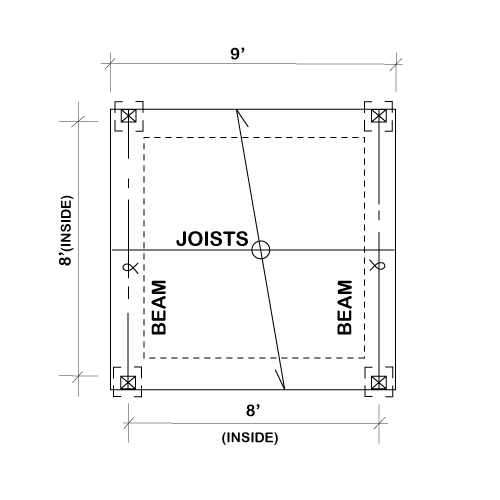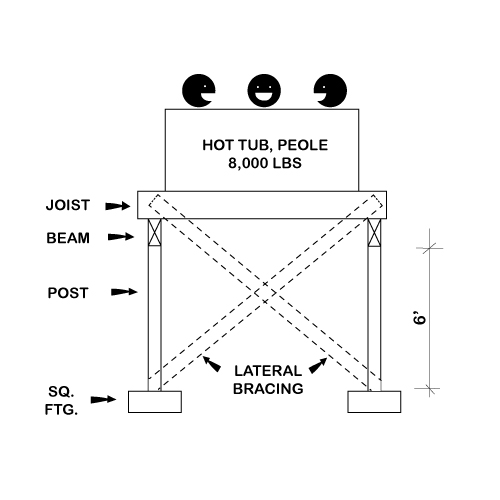If you've just joined us, we were discussing how beam size is crucial
especially when you have to support a hot tub with 8,000 lbs of hot
water and bathers.
In this example we used the ConstructionCalc Wood Beam Calculator to make the calculations for us so our deck doesn't collapse.
Tim Garrison, the mind behind all the ConstructionCalc software was
kind enough to provide the following explanation how to design the beam
size for this hot tub deck.
This is step 5 from Tim's Deck Design Explanation. Read the full pfd version here.
Wood Beam Calculator
Here are the top and side views of the hot tub deck design.
3) Beam Design.
Beam Design (This example will go a little faster because I won't repeat the basic stuff learned in the joist design above.)
Click here to get a pdf version of the beam design report.
- Let's input the required data into the Wood Beam Calculator:
|
|
- General: Change Beam ID from Joist to Beam (optional).
- Span: Inside of post to inside of post is 8' (pure coincidence
that this turns out the same as the joists span; it usually doesn't work
this way).
- Deflection: Use L/360 and L/240 defaults
- Load Duration: Ten years live
- Add Self Weight? Yes we want to add the beam's self weight to
the design because the 15 psf dead load we'll use in a minute does not include
the beam's self-weight (though it does include the weight of the joists
and decking).
- Loads Other Than Uniform? No, because the loads applied to this
beam comes from uniformally spaced joists of equal length and loading. In
other words, the beam's load is uniform across the beam's length - there's
no point loads or other weird loads.
- Uniform Loads Over Full Length of Member: Let's use the same
Floor. Load row as before:
|
|
- Live: 125, same as before
- Dead: 15, same as before
- Tributary Width: This is the only loading criteria that changes.
|
This beam gets its load from the joists, and in particular half the span
of the joists goes to this beam. The other half of the joist's load goes
to the beam on the other side of the deck. So the tributary width for this
beam is half of the joist's span: 8/2 = 4'. Done, now let's check results.
|
|
|
We need Hem Fir, pressure treated again, so let's give ourselves a couple
options:
|
|
- Tripled 2x. In the 4x And Smaller section; first, this beam gets no
help from another member, i.e. it acts alone so we select No to Repetitive
Member Use? Make sure Hem Fir, No.2 is selected in the drop-downs and you
can see that (3) 2xlO's work.
- Single Beam. In the 5x and Larger section, select Hem Fir, No.2 and
a 6x12 or 8xlO are all that will work.
- But Wait. Back in the 4x and Smaller section we see that a 4x12 also
works. This may come in handy if we want to use 4x posts.
|
|
|
|
- I like the 4x12 because I want to use 4x posts and want my beam to match
up well. Selecting it shows it makes it by 14.8% - okay, even for a pressure
treated member.
- Minimum Bearing Length is 1.58" - okay. This beam will sit on
posts of at least 4x4 dimension, so there will be plenty of space to accommodate
1.58" bearing length.
- Print the results if you wish. You've got your deck beam size!
- Check your work. If you're worried you may have goofed something
on the input and want a rough check, first, look at the Load and Span Diagram
in the upper right of the sheet. The span is shown in feet on the horizontal
axis and the loads on the vertical. A uniform load will look like a rectangular
box over the entire beam.
Now take a look at the Reactions at the bottom of the sheet. We
know the hot tub and occupants weighs 8,000 lbs; plus the deck itself (dead
weight) will be a couple or few hundred pounds.
|
|
So the beam size we just designed for this hot tub deck should carry half
of this total weight or about 4,200 lbs give or take (the beam on the other
side of the deck carries the other half). Because our beam is loaded uniformly, we'd expect each end to have the
same reaction, which should be half of our 4,200 lbs = 2,100 lbs, give or
take. The printout shows reactions at each end of our beam of 2,240 lbs.
Close enough; we're good to go.
|
|
Let's go to the next page and learn how to design and calculate the post
size to support this hot tub.




























